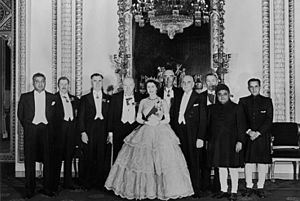1952 Commonwealth Prime Ministers' Economic Conference facts for kids
Quick facts for kids 1952 Commonwealth Prime Ministers' Economic Conference |
|
|---|---|

Photoshoot during the conference
|
|
| Host country | |
| Dates | 28 November–12 December 1952 |
| Cities | London |
| Participants | 8 |
| Chair | Winston Churchill (Prime Minister) |
| Follows | 1951 |
| Precedes | 1953 |
| Key points | |
|
Commonwealth trade, imperial preference, Sterling area, ANZUS Treaty, Royal Styles and Titles, Head of the Commonwealth
|
|
The 1952 Commonwealth Prime Ministers' Economic Conference was an important meeting of leaders from countries in the British Commonwealth. It was called by the British government, led by Prime Minister Sir Winston Churchill. The meeting took place in London, United Kingdom, from November 28 to December 12, 1952.
This conference happened because Britain was facing some tough times with its economy and military strength. At the same time, the United States was becoming a very powerful country in the world. The leaders met to talk about big issues affecting their countries and the Commonwealth.
Contents
Commonwealth Meeting in 1952
The main goal of the 1952 meeting was to discuss money and trade. The leaders also talked about a military treaty and the new Queen's titles.
Talking About Money
A big topic was how easily British money (the Pound sterling) could be swapped for American dollars. Britain was worried that some Commonwealth countries were saving up British pounds just to turn them into American dollars. They also discussed the future of the Sterling area, which was a group of countries that used the Pound sterling for trade.
The leaders also wanted to make trade easier between Commonwealth countries. They looked at "imperial preference", which were special trade rules that favored countries within the British Empire. This was important because the American economy was growing fast. Countries like Australia wanted American businesses to invest in their development. Britain, however, was concerned that America's growing power might hurt Britain's own economy.
Most Commonwealth countries, except for Canada, shared a common pool of gold and dollar reserves. This made the money discussions very important for everyone. In the end, they didn't agree on many specific economic plans. The final statement was described as just "general statements" rather than clear actions.
A Treaty for Safety
Another important topic was the ANZUS military treaty. This treaty was an agreement for defense between Australia, New Zealand, and the United States. Britain was worried about being left out of this important defense agreement.
The prime ministers at the conference released a statement together. They supported Britain's request to have a say in the ANZUS treaty. This showed that the Commonwealth leaders stood together on important security matters.
The Queen's New Titles
The leaders also talked about Queen Elizabeth II, who had just become queen. For months, they had discussed whether she should have the same Royal Styles and Titles in all Commonwealth countries. Or, should each country be able to choose its own titles for her?
They finally agreed that each Commonwealth country "should use for its own purposes a form of the Royal Style and Titles which suits its own particular circumstances but retains a substantial element which is common to all." This meant each country could have a unique title for the Queen, but it would still include a part that was the same everywhere. They also agreed to pass laws in their own countries to make this official.
The prime ministers also announced that Queen Elizabeth II would become the Head of the Commonwealth. She took over this role from her late father, King George VI.
Who Was There?
Here are the leaders who attended the 1952 Commonwealth Prime Ministers' Economic Conference:
| Nation | Name | Role |
|---|---|---|
| Winston Churchill | Prime Minister (Chairman) | |
| Robert Menzies | Prime Minister | |
| Dudley Senanayake | Prime Minister | |
| Sir Chintaman Deshmukh | Finance Minister | |
| Sidney Holland | Prime Minister | |
| Sir Khawaja Nazimuddin | Prime Minister | |
| Sir Godfrey Huggins | Prime Minister | |
| Nicolaas Havenga | Finance Minister |

